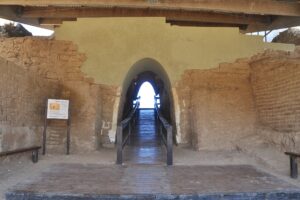Why Were Hundreds of Dogs Buried at Ashkelon? Lawrence E. Stager, Biblical Archaeology Review (17:3), May/Jun 1991.

Restored Canaanite city gate of Ashkelon, By Sarah Murray from South Bend, IN, USA – 17475 Flickr, CC BY-SA 2.0, https://commons.wikimedia.org/w/index.php?curid=35022531
This is part II of a three-part article. Part I appeared in the last issue (“When Canaanites and Philistines Ruled Ashkelon,” BAR 17-02). Part III will appear in the next issue (“Eroticism and Infanticide at Ashkelon,” BAR 17-04).
Ancient Ashkelon, now quietly nestled beside the Mediterranean in the south of Israel, is shaped like a giant 150-acre bowl, with the sea wearing away at much of the western half. The rim and sides of the bowl are formed by the mammoth Middle Bronze Age glacis, or rampart, that once protected the city. Inside the bowl are buried at least 20 ancient cities, dating from about 3500 B.C. to 1500 A.D., a span of 5,000 years.
In the last issue, we examined the Middle Bronze and Iron Age cities—the first, Canaanite and the second, Philistine.
In 604 B.C., Philistine Ashkelon was destroyed by the neo-Babylonian king Nebuchadrezzar (neb-uh-kuh-DREZ-uhr; also called Nebuchadnezzar [neb-uh-kuhd-NEZ-uhr]), whose army soon thereafter (in 586 B.C.) destroyed Jerusalem, capital of the kingdom of Judah, together with its Temple. Thus began what is known in Israelite history as the Babylonian Exile. Less widely known is the fact that the Philistines too were exiled to Babylon.
The Babylonians were replaced (in 538 B.C.) by the Persians, who expanded and then ruled the biggest empire the world had known before Alexander the Great—from the eastern Mediterranean to India. A more benign imperial power than the Babylonians—perhaps we may even characterize their hegemony as enlightened—the Persians under Cyrus the Great allowed the Jews to return to their land and even to rebuild their Temple (Ezra 1-2–4, 6-3–5).
Read the rest of Why Were Hundreds of Dogs Buried at Ashkelon? in the online Biblical Archaeology Society Library.




Since these burials were concentrated in a short time period, over about fifty years, and were all similar to one another, MAYBE it was all done by one off-beat person of the course of their lifetime: the local resident crazy dog lady/man, who took up the cause of giving a respectful burial to street dogs, in whatever space was available. That would explain the timespan, and the similar burial methods–if it was all done by one person. As to why they would do this against contemporary custom, well, you would have to ask that person. Maybe they had made a vow of some sort. Maybe it was penance. Maybe dogs were their main companions. Maybe the someone was autistic. Or had a ritualistic behaviour complex. When that person died, the burials stopped. Individuals have their quirks and habits, which are not reflected in their society as a whole. Whaddaya think about my theory? No missing sea-claimed temples are required, nor deep scholarship into cults of the day.